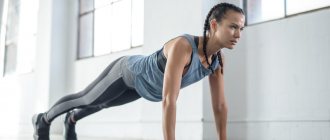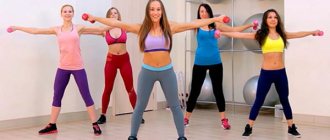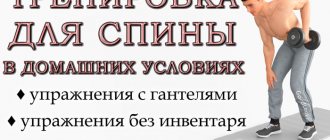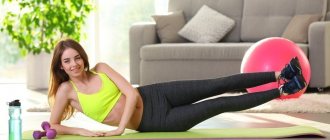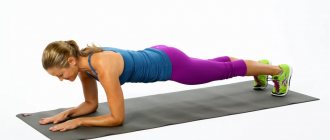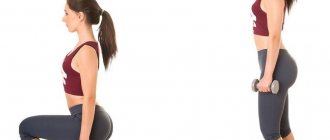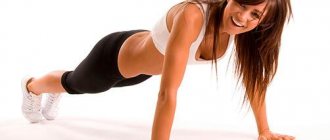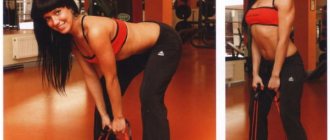The number of people involved in sports is growing steadily. An active lifestyle is becoming fashionable every day. Morning jogging, skiing in winter, cycling in summer, visiting fitness centers - a person himself chooses a convenient activity according to his taste and wallet.
What about home workouts? Is it possible to train at home? Or is systematicity, efficiency and motivation the destiny of group training? We'll figure out!
Benefits of Fitness at Home
Before proceeding directly to “home fitness”, we will describe its advantages.
- Saving
The effectiveness of classes is determined by their regular basis. At least a couple of days, and ideally three a week, should be devoted to fitness. Not everyone will be able to systematically pay for sports subscriptions! If you were wondering how much it costs to go to the gym, you were probably unpleasantly disappointed by the high cost (especially in big cities). And home classes are absolutely free.
- Independence
The student chooses the time and mode himself. Morning, afternoon, evening, weekdays, weekends, a full training complex, working on a separate problem area - is determined by personal desire and the availability of free time. Here you are your own boss (or mistress:)
- Psychological aspect
Group classes are out of the comfort zone for many. Elementary embarrassment plays a big role. Let's not deceive each other - often, the desire to go in for sports is dictated by dissatisfaction with one's appearance. And home conditions allow you to focus on results without being distracted by imaginary shortcomings.
Home workouts: advantages and disadvantages
Increasingly, those who want to reduce their weight decide to do home workouts. Video classes with professional trainers are very popular all over the world. So, what are the pros and cons of home workouts, and what is better to choose a fitness room or video sports at home?
STEP-BY-STEP INSTRUCTIONS: how to start losing weight
Benefits of home workouts:
- Saving money. First of all, you don't have to spend money on a gym membership. For those who are not sure that they can visit a fitness club regularly, this is one of the most important arguments. Secondly, you save money on travel.
- Variety of workouts. Now you can watch and buy a huge variety of video training, which are offered by various trainers. Moreover, you can choose the level of classes depending on your preparation. Not every fitness room has such a variety of workouts in its arsenal.
- Save time. You don’t need to waste time traveling to the gym, this is especially a pressing issue for residents of big cities. And if you attend group classes, then there is no need to adjust to the set training time.
- Psychological comfort. If you are embarrassed to train in front of strangers due to poor physical fitness, then home training will be an excellent solution for you. By working out at home, you don’t have to worry about the fact that doing push-ups, for example, is still an unsolvable task for you.
- Convenience. We can’t help but mention the convenience of home training: you don’t need to travel anywhere, worry a lot about your appearance and sportswear, and plan your day depending on your trip to the gym. You can study either early in the morning or late in the evening - it’s all at your discretion.
For training at home, we recommend checking out the following articles:
- Fitness elastic band (mini-bend): what is it, where to buy + 40 exercises
- All about fitness bracelets: what they are and how to choose
- Top 15 Tabata training videos from Monika Kolakovskaya
- Running in the morning: benefits and effectiveness, basic rules and features
- Top 20 exercises to improve posture (photo)
- Elliptical trainer: what is it for, pros and cons
- Exercise bike: pros and cons, effectiveness for weight loss
- How to remove sides: 20 main rules + 20 best exercises
Disadvantages of home workouts:
- Lack of a coach. Independent exercises that are performed without the supervision of a trainer can lead to errors in technique when performing exercises. And this is fraught not only with poor results, but also with injuries.
- Home furnishings. Not everyone has enough space in their apartment for training, and if you have restless neighbors living downstairs, you can completely forget about cardio classes. It's good if you have thick carpets on your floors, and your home environment allows you to train hard. And if not?
- Lack of motivation. Regular sports activities require motivation. Agree, if you have a paid gym membership, the likelihood of forcing yourself to go to a workout is much higher. After all, you can’t throw money away.
- Lack of exercise equipment. If you can buy a mat, dumbbells and even a barbell, then with large exercise equipment it is already more difficult. In addition, many fitness centers also include access to the pool and sauna in the membership, which is also a definite plus.
- Distractions. If when you come to the gym, you can say with confidence that half the work is done, then with home workouts everything is more difficult. My husband distracted me, my friend called me on the phone, my child became capricious, my favorite TV series started - everything tries to distract me from my studies.
Tips for training at home
The effectiveness of physical activity depends on a number of factors.
- Systematicity
Regular training will help you achieve the desired result. Without this there will be no result! If you give up, all your achievements will be nullified.
- A smart approach to starting
You need to become an “athlete” wisely. Start small: you don’t need to take on everything at once, increase the load gradually. No one expects records from you, and you should think about your health!
- The correct start and end of self-training
Strength training at home should begin with a warm-up, which includes stretching and cardio exercises. And it’s better to end physical activity with relaxation: a two-minute rest in “shavasana” or “dead man’s pose” will consolidate the result.
- Planning
Develop the most convenient training plan: an hour-long approach several times a week or a fifteen-minute set of exercises every day. Having a chart like this in front of you is stimulating! We recently wrote about how important it is to take the training process seriously in the article “Three pitfalls on the path to an ideal figure,” read it.
When asked about home workouts, a very common answer is “...I can’t bring myself to workout at home.” All these are nothing more than excuses. If a person cannot force himself to get up from the couch and perform a set of simple exercises with his own weight or dumbbells, then how can he regularly go to the gym 3-4 times a week, follow a healthy diet, while spending his energy, time and money. It's all about motivation, discipline and proper organization of your training regime.
Here are some of the main benefits of exercising at home.
Saving
Visiting the gym requires not only effort and time, but also financial costs. Typically, most modern gyms offer annual memberships, with a one-time payment for the entire year, which amounts to a decent amount of money. Plus the loss of time spent on the road. In addition, no one will return the money you spent if you get sick or don’t go to the gym for some other reason.
Positive example
Training at home or on the sports field has a positive motivational effect on others. In addition to beautiful conversations about health and the benefits of playing sports, you can motivate the people around you by your own example. This will serve as a much more convincing argument than mere words.
Convenience
Includes the following points:
- You don't have to spend money on expensive sportswear or suit;
- at home you can study to your favorite music;
- no need to wait until the machine you need becomes available;
In general, at home you have the right to organize your training process according to your personal requirements, without the restrictions and conventions that exist in a fitness room.
Psychological factor
Not everyone can expose their weakness to everyone. For example, perform a barbell press with an empty bar, while your neighbor is doing a biceps exercise with a barbell weighing 50 kg. At best, this will hurt his pride; at worst, the novice athlete will try to prove that he is no worse and will take such a weight that will inevitably lead to injury.
Another factor that may cause discomfort when visiting the gym is excess weight. Overweight people may feel embarrassed. This problem is eliminated when playing sports at home.
Hygiene
Another nice advantage compared to the gym. You have your own shower at home, sports equipment is not soaked in the sweat of strangers and is customized for you, and there are no visitors nearby who do not take care of their hygiene and simply do not use deodorant.
In conclusion, I would like to say that if you want to have the muscles of an athlete or just a slim and toned figure, then training at home will be a worthy replacement for the gym.
A beautiful body at home is not a myth, it is reality!
VN:F [1.9.22_1171]
Rate this article
Rating: 4.5/ 5 (4 votes cast)
We recommend articles:
What is Street Workout
5 main indicators of physical level
Jump rope. Burn fat
A set of exercises at home for different muscle groups
What exercises to do at home? Pay attention to problem areas, which are often the stomach, thighs, buttocks, and arms (in the triceps area). The best effect will be obtained by alternating aerobic and strength exercises. The first ones are effective in the form of aerobics with dance elements, or jumping on a step platform. An exercise bike or ellipse would also be a good option here. The effect can be diversified and enhanced by using additional sports equipment: dumbbells, weights, fitball, weights for arms or legs.
A home workout program for weight loss can be as follows:
- alternating strength and aerobic exercise during one workout;
- separation of aerobic and strength training by day.
How to remove belly fat?
“I can’t lose weight after giving birth,” “I want a sculpted tummy,” “How to get in shape?” Sound familiar? The stomach and buttocks are two stumbling blocks for many girls. I want to remove the first one, and I want to make the second ones elastic and give them shape. Yes, you can torture yourself with diets and healthy eating, but you can’t do without physical activity. Muscles should always be in good shape. And that's a fact. You will never achieve results on a diet alone!
Who is home workouts suitable for?
So, who is home workouts suitable for? Training at home is suitable for those who set themselves the following goals:
- lose weight and tone your muscles;
- putting yourself in order to go out into the world, so to speak, in our case means preparing yourself for visiting the gym (in the case of very low self-esteem);
- regain your shape after childbirth;
- strengthen the cardiovascular system;
- develop endurance;
- and even see the relief of muscles on your body.
The last point, of course, will not be easy to achieve, but it is still possible! As I have repeatedly said and written, “Abs on the stomach are made primarily in the kitchen, and not in the hall (at home)!” So training at home can cope with the above tasks 100%.
Now let’s figure out what tasks and goals home training is not suitable for:
- building muscle mass (although there are some nuances here, we’ll talk about them a little later);
- preparation for professional fitness and bodybuilding competitions;
- development of strength.
As you can see, there are many more tasks that training at home can handle than those that they cannot handle. And the girls I work with, basically all want to change their lifestyle and get their body in shape primarily for themselves, so the task of this article is to convince you, dear girls, that working out at home is POSSIBLE and NEEDED! In any case, it's better than not doing it AT ALL!
Here's an example of effective training for sculpted abs
It consists of only five simple elements. The complex is designed taking into account the development of all abdominal muscles: upper, lower abs and oblique muscles. We don't need cubes in only one part of the tummy, do we? Everything should be beautiful and symmetrical! It is recommended to do the complex daily.
- Crunches
Twisting can be straight, lateral, or reverse.
- first - from the position “lying down, legs bent at the knees” we raise the upper body - the upper abs work;
- the second - the same thing, but at the same time we bend our knees and reach for it with the opposite elbow - the oblique abdominal muscles are involved;
- third - we pull our knees towards ourselves and lift our buttocks - we work out the lower abs.
- 2 Lower limb raises
We do this lying on our back. If you have a horizontal bar or wall bars at home, we perform lifts hanging on the crossbar, this is much more effective! The lower press is involved. An additional effect will be added by the “scissors” element when raising and lowering the legs or a fitball clamped by the calves of the legs.
- "Half Birch"
We strengthen the previous element by lifting the buttocks and lower back. The upper press is connected to the work. We perform the exercise lying on our back, placing our arms along the body.
- "Boat"
From the “sitting” pose, we tear off the limbs by stretching them. We try to stay on our buttocks.
- "Bike"
We spin the bike while lying on our back. The upper body is in the air, rhythmically tilting the elbows towards the opposite knee. All abdominal muscles are worked. A very effective exercise. Want more effect? Use leg weights.
What exercises can you do in your apartment? Training without equipment
Not everyone has the opportunity to organize a home gym, and sometimes you don’t feel like going to a fitness center. But this does not mean that you should skip training. World Class Master Trainer Alexander Karpov
offers a set of 5 exercises that can be performed literally anywhere - in an apartment, a hotel, and even on the beach.
Gym on the balcony: 7 ideas for organizing a space for training
It is not necessary to have a spacious loggia.
Jumping out of a lunge with alternating legs
Muscle group:
quadriceps, hamstrings, glutes, calves.
Number of repetitions:
30.
Initial position
– standing, legs together, back straight, arms down along the body. Take a step forward, as in a normal lunge, squat until the knee of your front leg bends at a right angle. At this moment, jump out, simultaneously changing the position of your legs - after landing, the supporting leg should be in front.
During the exercise, try to maintain balance and watch your knees - in the forward position they should not go beyond the foot.
Push-ups with wide arms
Muscle group:
pectoralis major, triceps, deltoids.
Number of repetitions:
20.
Initial position
– emphasis lying on straight arms, palms slightly wider apart than shoulders, hands can be slightly spread to the side, body straight without bending in the lower back, abdominal muscles tense. As you inhale, begin to bend your arms, spreading your elbows to the side, lower yourself until your chest almost touches the floor. As you exhale, rise up and return to the starting position.
During push-ups, focus on contracting your pectoral muscles and feel the load.
What am I doing wrong? 5 common mistakes in push-ups
Progress will not keep you waiting if you get rid of these shortcomings.
Forearm extension from support
Muscle group:
pectoralis major muscles, triceps.
Number of repetitions:
15.
Initial position
– lying down, arms straight, slightly wider than the shoulders and pushed forward, body straight. Slowly bend your arms until your forearms touch the floor. At the same time, keep your elbows straight, do not spread them to the sides. Return to the starting position.
When performing the exercise, try not to move the line of your shoulders - your palms should be in front, and not directly under your shoulders, as with classic push-ups.
Torso flexion
Muscle group:
abdominal muscles.
Number of repetitions:
20.
Initial position
– lying down, legs slightly bent at the knees and raised at an angle of 45-60 degrees, if desired, you can cross them. Start bending your torso with your chin - stretch it to your chest and forward, gradually lifting your shoulders and back off the floor. Reach the highest possible point for you, and then return to the starting position.
Muscle burning after exercise is normal. But your lower back should not hurt - if you feel discomfort in your back, you may be doing the exercise incorrectly.
Seated torso twists, legs suspended
Muscle group:
internal and external oblique abdominal muscles.
Number of repetitions:
30.
Initial position
– sitting, legs slightly bent at the knees, body should form the letter “V”, back slightly rounded at the lower back, abs tense, arms bent at the elbows. Raise your legs off the floor and begin to twist left and right. The knees remain in place or move against the body.
7 home workouts. How not to gain weight during quarantine
In order to be in shape, you don’t have to leave the threshold of your apartment.
Exercises should begin with a 10-minute warm-up, and then perform in a circle. Rest time depends on your level of physical fitness. More advanced athletes can skip the breaks altogether and try to do the maximum number of laps in 45 minutes.
How to pump up your thighs and butt?
Moving on, let's look at the lower body. Firm buttocks and thighs are the ultimate dream of many girls. The secret is simple - movement. Walking, running, ignoring the elevator - and your butt will become toned. A ten-minute home exercise to pump up your hips and buttocks won’t hurt either.
- Squats
Numerous selfies of pseudo-fit people with endless squat exercises on Instagram are already pretty boring. But the fact remains that this is the main exercise for this purpose. It is effective to squat from the “feet shoulder-width apart” position. To pump up the lower body in a squat, keep your back straight and your toes straight. When lowering, we seem to sit down on a chair. We take our butt back and tense it. Of course, at home you will not have a barbell to throw it over your shoulders, but this is not required. If you need weight, use a fitball or weights.
Under no circumstances should we tilt our body forward when lifting! Otherwise, a lot of stress will fall on your back and lower back, and we don’t need that.
A squat with widely spaced lower limbs, where in addition to the buttocks, the hips work, is effective.
- Lunges
From the “standing” position, bend your leg at the knee and transfer your body weight to it. We take the other leg back. We change sides. You can strengthen the element with additional loads in the form of dumbbells.
- Swing your legs
Different positions are applicable: lying on your side (up), standing (sideways), on all fours (we move the leg as far back as possible and straighten it). It is necessary to cover all sides with swings.
- Butt lift
Lie on your back, bend your legs at the knee joints and lift your lower body. Several variations of the exercise are possible:
- feet shoulder width apart;
- legs together;
- the foot of one leg on the knee of the other.
Doing the training every day will make your butt firm and toned, and your legs beautiful.
Workout without iron at home
We present a set of exercises with your own weight that will allow you to pump up your body at home.
How to build a lesson
- Start your session with a short warm-up .
- Perform the exercises sequentially in the specified amount.
- Do this program 2-3 times a week .
- Always make the main effort while exhaling and do not hold your breath.
- Finish the session with stretching .
Squats
1 Squats
Stand straight, feet shoulder-width apart, toes pointing forward. Place your palms in front of your chest. Bend your knees, move your pelvis back and smoothly, in 4 counts, lower yourself into a squat. Then also smoothly, for 4 counts, return to the starting position. Don't slouch, don't bend in the lower back, work your abdominal muscles. This will make one repetition, do 3 of these. Then lower yourself into a squat again and, just short of reaching the bottom point, perform another 3-4 springing movements.
Reverse lunges with rotation
2 Lunges
Stand straight, feet shoulder-width apart, toes pointing forward. Bend your knees, move your pelvis back and smoothly lower into a squat. Then return to the starting position, step your left foot back and lower into a lunge. This will amount to one repetition, perform 8 such movements in each direction.
Bends on one leg
3 - Bends on one leg
Stand straight, place your feet parallel to each other, hip-width apart. Work the muscles of your abs, back, legs and arms. Shift your body weight to your right leg, bend your left leg, first pull your left knee towards your stomach, then move your left foot back. At the same time, smoothly lean your body forward, lower your left hand down (press your right hand to your body). Then smoothly return to the starting position and pull your left knee towards your stomach. This is one repetition, do 8 of these in each direction.
Plank jumps
4 Plank jumps
Stand in a plank position, supported by straight arms and toes, stretch your body in one line, do not bend your lower back, do not slouch, work your abdominal muscles. From this position, jump your feet closer to your hands, lifting your pelvis up and slightly rounding your back. Then jump your feet back to the starting position. This will amount to one repetition, do 8-10 of these.
Push ups
5 Push-ups
Take a lying position, leaning on straight arms. Place your palms wider than your shoulders, place your feet hip-width apart. Do not bend in the lower back, work your abdominal muscles, stretch your head forward and your feet back. In this position, bend your elbows, pointing them back towards your body, and lower your body down. Hold this position for 2-3 seconds, then smoothly return to the starting position, straightening your elbows. This will amount to one repetition, do 8-10 of these.
"Climber"
6 Climber
Stand in a plank position, supported by straight arms and toes, stretch your body in one line, do not bend your lower back, do not slouch, work your abdominal muscles. From this position, pull your bent left knee towards your stomach (you can turn it slightly to the right), then return to the starting position and pull your right knee towards your stomach. This will amount to one repetition, do 8-10 of these.
Crunches
22 crunches
Lie on your back, bend your knees, place your feet on the mat. Cross your arms over your chest. Smoothly lift the back of your head, neck and upper body above the floor. Work your abdominal muscles, try to turn off your leg muscles. Then lower your back first, then your neck and the back of your head. This will amount to one repetition, do 20 of these.
"Scissors"
26-scissors
Lie on your back, stretch your arms along your body. Raise your legs straight up, with your toes stretching away from you. Activate your abdominal muscles, lift your neck and head above the floor. Smoothly lower your left leg until it is parallel to the floor (the right leg is still extended upward). Then change the position of your legs: now the left one is extended upward, and the right one is lowered to parallel with the floor. This will amount to one repetition, do 8-10 of these.
Perhaps after 2-3 weeks of training according to this scheme, you will feel that it’s time to increase the load. Then you can increase the number of repetitions in each exercise. Or use other ways to increase the intensity of the activity.
How to strengthen your back and arms?
Weight loss challenges are not enough. Typically, people who have problems with excess weight suffer from a concomitant illness - osteochondrosis. Only a strong spine is the basis of health. And pumped up triceps and biceps always attract attention. Especially if it concerns males.
To strengthen your back and arms, the next portion of movements is perfect:
- From the “lying on your stomach” pose, we stretch our arms, raise them together with straight legs and make slow swinging movements.
- Push-ups performed both from the knees and on straight legs.
- Rolls on your back in different directions.
- Bending and extension of arms from different positions with weights in the form of dumbbells or weights.
- Reverse push-ups: sit with your back to the support, bend your legs and, resting your hands on the support, raise and lower your body.
The most effective position is the plank, which strengthens all muscle groups. Both plank variations are effective: straight and side. On the Internet you can easily find photos and videos of this seemingly simple, but in fact quite difficult and very effective exercise.
